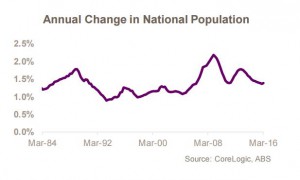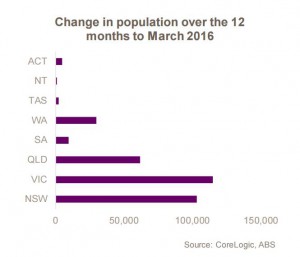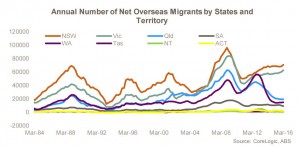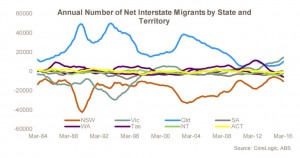In this 4 part series we look at the housing market conditions and key economic factors driving housing market conditions across Australia.
The current growth phase for capital city home values commenced in June 2012, almost four and a half years ago, and since that time capital city home values have increased by 42.0%.
To put the geographic differences in growth into perspective, over the current growth phase Sydney home values are 65.9% higher and Melbourne values are up 48.6%, the capital city with the third highest rate of growth was Brisbane where values have increased by a much more modest 19.0% over the period.
Today we look at population growth and how it affects our markets.
The national population increased by 1.4% over the year to March 2016
- At the end of March 2016, the national population was estimated to be 24,051,404 persons.
- Over the 12 months to March 2016, the population increased by 1.4% or 327,610 persons.
The recent slowdown in population growth has largely been driven by slowing net overseas migration
- At a national level there are two components of population growth; net overseas migration and natural increase (births minus deaths).
- Over the 12 months to March 2016, net overseas migration was recorded at 180,847 persons, an increase of 2.0% over the year
- Natural increase was -4.9% lower over the year and recorded at 146,763 persons.
- In comparison to other countries, Australia’s population is increasing at a rapid pace however, it has slowed substantially since net overseas migration peaked at 315,687 persons over the 12 months to December 2008.
Victoria is experiencing both the greatest increase and the fastest rate of population growth
- The population of New South Wales increased by 103,241 persons over the past year, a growth rate of 1.4%.
- Victoria recorded both the fastest rate of population growth over the past year (1.9%) and the greatest overall increase (114,865) which was also its greatest annual increase since June 2009.
- In Queensland, the population increased by 61,769 persons over the year which was its greatest annual increase since December 2014 and a 1.3% annual rate of growth.
- South Australia’s population increased by 0.6% over the past year with the total population increasing by 9,741 persons its lowest annual increase since December 2004.
- The population of Western Australia increased by 29,819 persons, its smallest annual increase since December 2004 while the rate of population growth was 1.2%.
- There was a 2,202 person increase in Tasmania’s population over the past year with the population increasing by 0.4% over the past year.
- Northern Territory’s population increased by 0.4% or 960 persons over the 12 months to March 2016.
- In the Australian Capital Territory, the rate of population growth was recorded at 1.3% over the past year resulting in an increase in population of 4,989 persons.
Overseas migrants are overwhelmingly choosing to settle in NSW or Vic
- Net overseas migration was greatest over the past year into New South Wales (70,780 persons) and Victoria (62,785).
- In fact, these two states accounted for almost three quarters of all net overseas migration over the year at 39.1% and 34.7% respectively.
- The 70,780 net overseas migrants into New South Wales over the past year was the greatest number since September 2009.
- Victoria’s net overseas migration of 62,785 persons is the greatest number of migrants for the state since December 2009.
- Net overseas migration into Queensland was recorded at 19,407 persons over the past year, well down on the peak of 62,840 in December 2008.
- South Australia attracted 9,441 net overseas migrants over the year, its lowest level since September 2011.
- There were 14,817 net overseas migrants to Western Australia over the year to March 2016 which is substantially lower than the peak of 56,753 net migrants over the year to September 2012.
- Tasmania recorded 1,117 net overseas migrants over the year which was the lowest number of overseas migrants to the state since March 2012.
- With 626 net overseas migrants over the year to March 2016, Northern Territory had its lowest level of net overseas migration since December 2003.
- The Australian Capital Territory had net overseas migration of 1,869 persons over the past year, its lowest level since June 2014
Net interstate migration into Victoria is the highest on record
- New South Wales recorded a net loss of 10,321 residents over the past year due to interstate migration which was its greatest net loss since December 2013.
- Net interstate migration added an additional 14,529 residents to Victoria over the past year, its greatest increase on record.
- Queensland gained 10,118 residents over the past year due to net interstate migration which was its largest annual gain since December 2012.
- In South Australia there was a net loss of 5,887 residents due to net interstate migration which was the state’s largest loss since June 1996.
- Western Australia recorded a net outflow of 5,624 residents over the past year due to net interstate migration which was its largest loss on record.
- Over the past year, 21 more residents moved to Tasmania than left and this was the greatest annual increase from net interstate migration since March 2011.
- The Northern Territory recorded a net loss of 2,451 residents due to net interstate migration over the past year which was the smallest outflow of residents since December 2013.
- Net interstate migration resulted in a net outflow of 385 residents of the Australian Capital Territory over the past year, the smallest outflow since December 2013.
This is the second of a 4 part series on the Australian housing market’s performance in 2016. Watch out for the next instalment in the next few days.
You may want to read part 1- Year End Australian Property Market Review








No comments:
Post a Comment